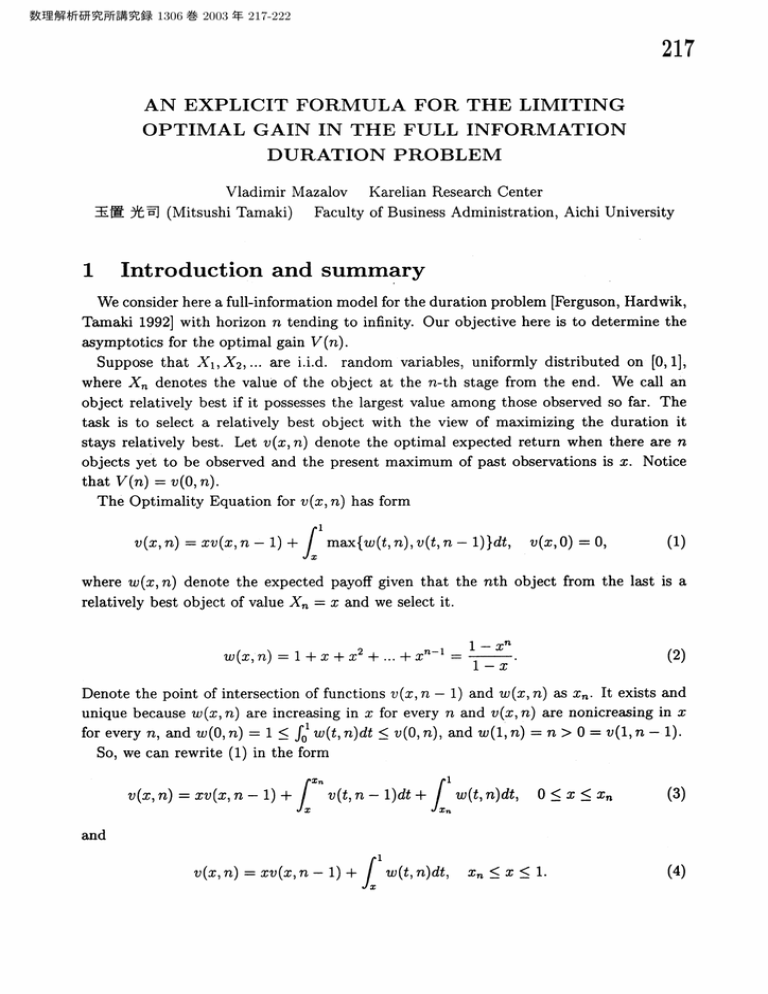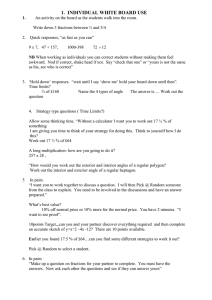1 Introduction and summary
advertisement

数理解析研究所講究録 1306 巻 2003 年 217-222
217
AN EXPLICIT FORMULA FOR THE LIMITING
OPTIMAL GAIN IN THE FULL INFORMATION
DURATION PROBLEM
Vladimir Mazalov Karelian Research Center
玉置 光司 (Mitsushi Tamaki)
Faculty of Business Administration, Aichi University
1
Introduction and summary
We consider here afull-information model for the duration problem [Ferguson, Hardwik,
Tamaki 1992] with horizon tending to infinity. Our objective here is to determine the
asymptotics for the optimal gain $V(n)$ .
,
, are i.i.d. random variables, uniformly distributed on $[0, 1]$ ,
Suppose that
where
denotes the value of the object at the -th stage from the end. We call an
object relatively best if it possesses the largest value among those observed so far. The
task is to select arelatively best object with the view of maximizing the duration it
stays relatively best. Let $v(x, n)$ denote the optimal expected return when there are
objects yet to be observed and the present maximum of past observations is . Notice
that $V(n)=v(0, n)$ .
The Optimality Equation for $v(x, n)$ has form
$n$
$X_{1}$
$X_{2}$
$\ldots$
$X_{n}$
$n$
$n$
$x$
$v(x, 0)=0$ ,
$v(x, n)=xv(x, n-1)+ \int_{x}^{1}\max\{w(t, n), v(t, n-1)\}dt$ ,
(1)
where $w(x, n)$ denote the expected payoff given that the nth object from the last is a
relatively best object of value $X_{n}=x$ and we select it.
(2)
$w(x, n)=1+x+x^{2}+ \ldots+x^{n-1}=\frac{1-x^{n}}{1-x}$ .
Denote the point of intersection of functions $v(x, n-1)$ and $w(x, n)$ as . It exists and
unique because $w(x, n)$ are increasing in for every and $v(x, n)$ are nonicreasing in
for every , and $w(0, n)=1 \leq\int_{0}^{1}w(t, n)dt\leq v(0, n)$ , and $w(1, n)=n>0=v(1, n-1)$ .
So, we can rewrite (1) in the form
$x_{n}$
$x$
$x$
$n$
$n$
$v(x, n)=xv(x, n-1)+ \int_{x}^{x_{n}}v(t, n-1)dt+\int_{x_{n}}^{1}w(t, n)dt$
,
$0\leq x\leq x_{n}$
(3)
and
$v(x, n)=xv(x, n-1)+ \int_{x}^{1}w(t, n)dt$ ,
$x_{n}\leq x\leq 1$
.
(4)
218
If we stop the selection with arelatively best object $X_{n}=x$ , we receive
continue and select the next relatively best object, we expect to receive
$u(x, n)$
$=$
$\sum_{k=1}^{n-1}x^{k-1}\int_{x}^{1}\mathrm{w}(\mathrm{x}, n-k)dt$
$=$
$\sum_{k=1}^{n-1}x^{k-1}\sum_{j=1}^{n-k}(1-x^{j})/j$
$w(x, n)$ .
If we
.
(5)
The problem is monotone [Ferguson et , 1992], so the one-stage look-ahead rule (OLA)
is optimal here and prescribes stopping if $w(x, n)\geq u(x, n)$ ;that is, if
$\mathrm{a}1$
$\sum_{k=1}^{n}x^{k-1}(1-\sum_{j=1}^{n-k}(1-x^{j})/j)\geq 0$
.
(6)
It is equivalent that we stop selection on the step if the relatively best object has value
(see the fig. 1) with
as the solution of the equation (6).
$n$
$X_{n}\geq x_{n}$
$x_{n}$
1
According to [Porosinski, 1987],
$x_{n}$
written as
$x_{n}=1-z_{n}/n$
satisfies the equation
,
$\sum_{k=1}^{n}(1-\frac{z_{n}}{n})^{k-1}(1-\sum_{j=1}^{n-k}(1-(1-\frac{z_{n}}{n})^{j})/j)=0$
must converge to aconstant,
and from here
integral equation
$z_{n}$
$z_{n}arrow z$
, where
$\int_{0}^{1}e^{-zv}[1-\int_{0}^{1-v}\frac{1-e^{-zu}}{u}du]dv=0$
.
$z\approx 2.11982$
satisfies the
219
Lemma 1.
Proof.
and
$V(n)arrow\infty$
as n
$arrow\infty$
.
It follows immediately from the inequality
$u(0, n)= \sum_{j=1}^{n-1}1/jarrow\infty$
as
$narrow\infty$
Lemma 2. There exists aconstant
Proof.
every x
$v(x, n)\geq u(x, n+1)$
for every
$x$
,
$n$
.
such that
$C$
$V(n)\leq Cn$
for all .
$n$
Suppose that it is true for some n–1. Then from (3) $-(4)$ it follows that for
, the sequence
. Because
$v(x, n)\leq C(n-1)+\epsilon_{n}$ where
$\epsilon_{n}=\int_{x_{n}}^{1}w(t, n)dt$
$\epsilon_{n}$
$=$
$\sum_{j=1}^{n}\frac{1-x_{n}^{j}}{j}$
$=$
$\sum_{j=1}^{n}\frac{1-(1-zAn)^{j}}{j}$
$=$
$\sum_{j=1}^{n}\frac{1-(1-z_{1\vec{n}})^{L}\mathrm{J}nn}{j/n}\frac{1}{n}$
$z_{n}arrow z$
converges to $\int_{0}^{1}(1-e^{-zx})/xdx\approx 1.3700$ and, consequently, it is bounded by some constant
. Hence, if we choose $C\geq e$ we obtain $v(x, n)\leq Cn$ for all .
, i.e.
$e$
$x$
$\epsilon_{n}\leq e$
Remark. So, the function
than Cn.
Lemma 3. Function
$V(n)$
$u(x, n)$
tends to infinity not slower than
satisfies
$\log n$
and not faster
the equation
$u(x, n)=xu(x, n-1)+ \int_{x}^{1}w(t, n-1)dt$ ,
$u(x, 1)=0$ .
Proof. It follows from direct calculations
$u(x, n)-xu(x, n-1)$
$=$
$\sum_{k=1}^{n-1}x^{k-1}\int_{x}^{1}w(t, n-k)dt-\sum_{k=1}^{n-2}x^{k}\int_{x}^{1}w(t, n-1-k)dt$
$=$
$\sum_{k=1}^{n-1}x^{k-1}\int_{x}^{1}w(t, n-k)dx-\sum_{k=2}^{n-1}x^{k-1}l^{1}w(t, n-k)dx$
$=$
$\int_{x}^{1}w(t, n-k)dx$
.
Let us introduce two new functions
$y(x, n)=v(x, n)-u(x, n+1)$ ,
$\Delta_{n}(x)=u(x, n)-w(x, n)$ .
(7)
220
In the interval [0,
both functions are non-negative and
and (7), $y(x,$n) satisfies the equation
$\Delta_{n}(x_{n})=0$
$x_{n}]$
$y(x, n)=xy(x, n-1)+ \int_{x}^{x_{n}}[y(t, n-1)+\Delta_{n}(t)]dt$ ,
and $y(x, n)=0$ , for
and
$x\geq x_{n}$
$y(x, 3)= \int_{x}^{x\mathrm{s}}\Delta_{3}(t)dt$
Lemma 4. Function
$0\leq x\leq x_{n}$
. Also, notice that $y(x, 1)=y(x, 2)=0$ (because
, where
$\Delta_{n}(x)$
$\Delta_{3}(x)=1/2-x-5/2x^{2}$
satisfies
,
(8)
$x_{1}=x_{2}=0$ )
.
the equations
$\Delta_{n}(x)=x\Delta_{n-1}(x)+\int_{x}^{1}w(t, n-1)dt-1$
,
$\Delta_{1}(x)=-1$
$\Delta_{n+1}(x)-\Delta_{n}(x)=\sum_{j=1}^{n}\frac{x^{n-j}-x^{n}}{j}-x^{n}$
Proof.
. According to (3)
.
.
(9)
(10)
(9) follows from Lemma 3and the simple identity
$w(x, n)=xw(x, n-1)+1$ .
Prom (9) we obtain
$\Delta_{n+1}(x)-\Delta_{n}(x)=x[\Delta_{n}(x)-\Delta_{n-1}(x)]+\frac{1-x^{n}}{n}$
After
$n$
.
iterations we have
$\Delta_{n+1}(x)-\Delta_{n}(x)=\sum_{j=1}^{n}\frac{x^{n-j}-x^{n}}{j}+x^{n}[\Delta_{1}(x)-\Delta_{0}(x)]$
With
$\Delta_{1}(x)-\Delta_{0}(x)=-1$
Differentiating (8) in
$x$
it proves (10).
we obtain
$y’(x, n)=xy’(x, n-1)-\Delta_{n}(x)$ ,
and, consequently,
.
$y’(x, 3)=-\Delta_{3}(x)$
$0\leq x\leq x_{n}$
,
,
$-x\Delta_{3}(x)-\triangle_{4}(x)$
$y’(x, 4)=\{$
$-\Delta_{4}(x)$
,
$y’(x, n)=- \sum_{j=\dot{|}}^{n}$ $x^{n-j}\Delta_{j}(x)$
,
,
if
$0\leq x\leq x_{3}$
if
$x_{3}<x$
$\leq x_{4}$
and
$x_{i-1}\leq x\leq x_{i}$
, $i=3,4$ ,
$\ldots$
, .
$n$
(10)
221
In integral form (11) is
$y(x, n)= \sum_{j=i}^{n}\int_{x}^{x_{j}}t^{n-j}\Delta_{j}(t)dt$
Letting in (12)
$x=0$
,
$x_{i-1}\leq x\leq x_{i}$
, $i=3,4$ ,
, .
(12)
$n$
$\ldots$
we obtain
Lemma 5.
.
$y_{n}=y(0, n)= \sum_{j=3}^{n}\int_{0}^{x}j$ $t^{n-j}\Delta_{j}(t)dt$
Consider now the difference
$r_{n}=y_{n+1}-y_{n}$
(13)
.
. Using (13) we can represent it as asum of
two expressions
$r_{n}$
$=$
$y_{n+1}-y_{n}$
$=$
$\sum_{j=3}^{n}\int_{0}^{x_{j}}t^{n-j}[\Delta_{j+1}(t)-\Delta_{j}(t)]dt+\sum_{j=3}^{n+1}\int_{x_{j-1}}^{x_{j}}t^{n-j+1}\Delta_{j}(t)dt$
(14)
Using (10) the first sum in (14) can be rewritten in the form
$\sum_{j=3}^{n}$
As
$\int_{0}x_{j}$
$tn$
$narrow\infty$
$-j$
$[ \sum_{i=1}^{j}$
letting
$\frac{t^{j-ij}-t}{i}$
–
$t^{j}]$
$x_{n}=1-z_{n}/n$
$dt$ $=$
$\sum_{j=3}^{n}$
$\{$
$\sum_{i=1}^{j}$
$[ \frac{xjn-i+1}{n-i+1}$
–
$\frac{xjn+1}{n+1}]$
$\frac{1}{i}$
–
$\frac{xjn+1}{n+1}$
(11)
du.
Let us prove that the second sum in (14) tends to zero. Firstly notice that
for $x\geq x_{j-1}$ , consequently, from Lemma 4it follows that
$\Delta_{j}(x)\leq\int_{x}^{1}w(t,j-1)dt-1\leq\sum_{i=1}^{j-1}\frac{1}{i}$
,
$x\in[x_{j-1}, x_{j}]$
Hence,
$\leq$
$\sum_{j=3}^{n+1}\int_{x_{j-1}}^{x_{j}}t^{n-j+1}\Delta_{j}(t)dt$
$\leq \mathrm{I}\sum_{i=1}^{j1}\int_{x_{j-1}}^{x_{j}}\frac{t^{n-j+1}}{i}dt$
$=$
. (15)
we obtain that (15) converges to the integral
$C_{0}= \int_{0}^{1}e^{-\frac{z}{u}}[\int_{0}^{u}(\frac{e^{\frac{zv}{u}}-1}{v}+\frac{e^{\frac{zv}{u}}}{1-v})dv-1]$
0
$\}$
$\sum_{i=1}^{n}\frac{1}{i}\sum_{j=i+1}^{n+1}[\frac{x_{j}^{n-j+2}-x_{j-1}^{n-j+2}}{n-j+2}]$
.
$\Delta_{j-1}(x)\leq 0$
222
Using the inequality
$\leq$
$\sum_{i=1}^{n}\frac{1}{i}\sum_{j=i+1}^{n+1}[x_{j}^{n-j+1}(x_{j}-x_{j-1})]$
$=$
$\sum_{i=1}^{n}\frac{1}{i}\sum_{j=i+1}^{n+1}[(1-\frac{z_{j}}{j})^{n-j+1}(\frac{z_{j-1}}{j-1}-\frac{z_{j}}{j})]$
$1-x\leq\exp(-x),\forall x$ ,
.
(17)
(17) is not larger than
$\sum_{i=1}^{n}\frac{1}{i}\sum_{j=i+1}^{n+1}[\exp\{-\frac{z_{j}}{j}(n-j+1)\}(\frac{z_{j-1}}{j-1}-\frac{z_{j}}{j})]$
$\leq\exp\{Z\}\sum_{i=1}^{n}\frac{1}{i}\sum_{j=i+1}^{n+1}[\exp\{-\frac{z_{j}(n+1)}{j}\}(\frac{z_{j-1}}{j-1}-\frac{z_{j}}{j})]$
where $Z= \sup z_{j}$ . The last sum (18) converges as
and corresponding for internal sum integral
$\exp\{-z\}/(n+1)$ .
Summarizing all, we obtain the next result.
$narrow \mathrm{o}\mathrm{o}$
,
(18)
to zero, because $z_{n}arrow z$
is not larger than
$\int_{i+1}^{n+1}\exp\{-\frac{z(n+1)}{t}\}z/t^{2}dt$
Theorem 1. For large
$n$
$\frac{V_{n}}{n}arrow C_{0}$
,
is the value of the integral (16).
where
Proof follows immediately from
$C_{0}$
$\lim_{narrow\infty}V_{n}/n=\lim_{narrow\infty}v(0, \mathrm{n})/\mathrm{n}=\lim_{narrow\infty}[y_{n}+$
$u(0, n+1)]/n= \lim_{narrow\infty}[y_{n}+\sum_{j=1}^{n}1/j]/n=C_{0}$
. Package Mathematica calculates
$C_{0}\approx$
0.4351708.
REFERENCES
1. T.S.Ferguson, J.P.Hardwick, M.Tamaki, Maximization of duration of owning a relatively best object, Contemporary Mathematics, vol. 125, 1992, 37-57.
2. Z. Porosinski, The Full-information best-choice problem with a random number
observations, Stoch. Proc. and Appl. 24, 1987, 293-307
of

